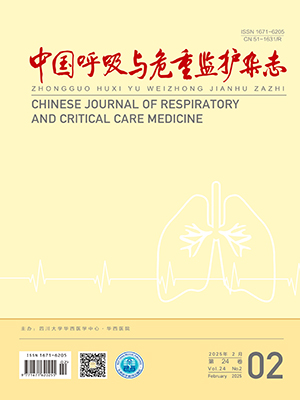| 1. |
中华医学会呼吸病学分会. 社区获得性肺炎诊断和治疗指南. 中华结核和呼吸杂志, 2006, 29(10): 651-655.
|
| 2. |
American Thoracic Society, Infectious Diseases Society of America. Guidelines for the management of adults with hospital-acquired, ventilator-associated, and healthcare-associated pneumonia. Am J Respir Crit Care Med, 2005, 171(4): 388-416.
|
| 3. |
Miller BW, Brennan DC, Korenblat PE, et al. Common variable immunodeficiency in a renal transplant patient with severe recurrent bacterial infection: a case report and review of the literature. Am J Kidney Dis, 1995, 25(6): 947-951.
|
| 4. |
Passalacqua JA, Wiland AM, Fink JC, et al. Increased incidence of postoperative infections associated with peritoneal dialysis in renal transplant recipients. Transplantation, 1999, 68(4): 535-940.
|
| 5. |
Fishman JA, Rubin RH. Infection in organ-transplant recipients. N Engl J Med, 1998, 338(24): 1741-1751.
|
| 6. |
Rubin RH. Infectious disease complications of renal transplantation. Kidney Int, 1993, 44(1): 221-236.
|
| 7. |
Ducloux D, Courivaud C, Bamoulid J, et al. Prolonged CD4 T cell lymphopenia increases morbidity and mortality after renal transplantation. J Am Soc Nephrol, 2010, 21(5): 868-875.
|
| 8. |
Schurmann M, Schurmann D, Schindler R, et al. Impaired thymic function and CD4+ T lymphopenia, but not mannose-binding lectin deficiency, are risk factors for Pneumocystis jirovecii pneumonia in kidney transplant recipients. Transpl Immunol, 2013, 28(4): 159-163.
|
| 9. |
Tu GW, Ju MJ, Han Y, et al. Moderate-dose glucocorticoids as salvage therapy for severe pneumonia in renal transplant recipients: a single-center feasibility study. Ren Fail, 2014, 36(2): 202-209.
|
| 10. |
Dupont PJ, Manuel O, Pascual M. Infection and chronic allograft dysfunction. Kidney Int Suppl, 2010, (119): S47-53.
|
| 11. |
Dizdar OS, Ersoy A, Akalin H. Pneumonia after kidney transplant: incidence, risk factors, and mortality. Exp Clin Transplant, 2014, 12(3): 205-211.
|
| 12. |
Chalmers JD, Singanayagam A, Hill AT. C-reactive protein is an independent predictor of severity in community-acquired pneumonia. Am J Med, 2008, 121(3): 219-225.
|
| 13. |
Boussekey N, Leroy O, Alfandari S, et al. Procalcitonin kinetics in the prognosis of severe community-acquired pneumonia. Intensive Care Med, 2006, 32(3): 469-472.
|
| 14. |
Menendez R, Martinez R, Reyes S, et al. Stability in community-acquired pneumonia: one step forward with markers?. Thorax, 2009, 64(11): 987-992.
|
| 15. |
Menendez R, Cavalcanti M, Reyes S, et al. Markers of treatment failure in hospitalised community acquired pneumonia. Thorax, 2008, 63(5): 447-452.
|
| 16. |
Bozza FA, Shah AM, Weyrich AS, et al. Amicus or adversary: platelets in lung biology, acute injury, and inflammation. Am J Respir Cell Mol Biol, 2009, 40(2): 123-134.
|
| 17. |
Thiery-Antier N, Binquet C, Vinault S, et al. Is thrombocytopenia an early prognostic marker in septic shock?. Crit Care Med, 2016, 44(4): 764-772.
|
| 18. |
Mueller C, Scholer A, Laule-Kilian K, et al. Use of B-type natriuretic peptide in the evaluation and management of acute dyspnea. N Engl J Med, 2004, 350(7): 647-654.
|
| 19. |
Hopkins WE, Chen Z, Fukagawa NK, et al. Increased atrial and brain natriuretic peptides in adults with cyanotic congenital heart disease: enhanced understanding of the relationship between hypoxia and natriuretic peptide secretion. Circulation, 2004, 109(23): 2872-2877.
|
| 20. |
Shor R, Rozenman Y, Bolshinsky A, et al. BNP in septic patients without systolic myocardial dysfunction. Eur J Intern Med, 2006, 17(8): 536-540.
|
| 21. |
Li J, Ye H, Zhao L. B-type natriuretic peptide in predicting the severity of community-acquired pneumonia. World J Emerg Med, 2015, 6(2): 131-136.
|




